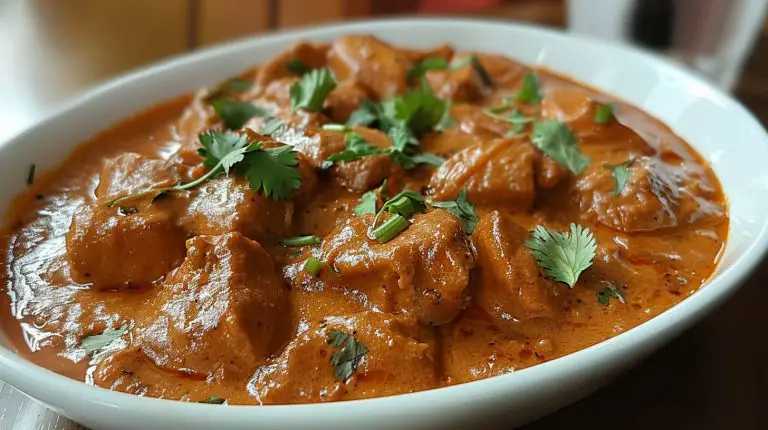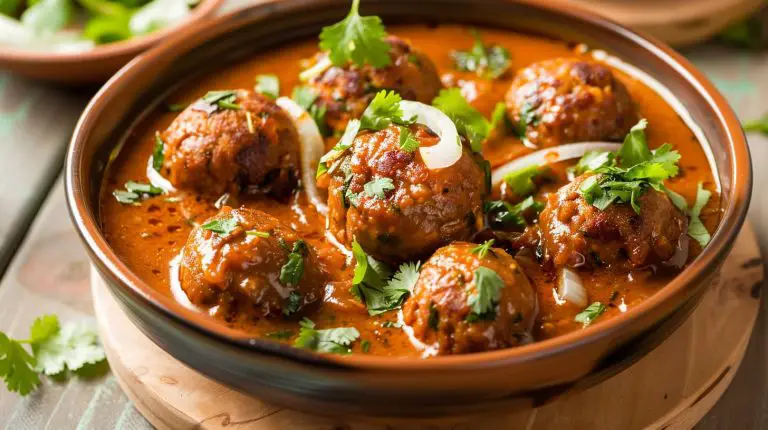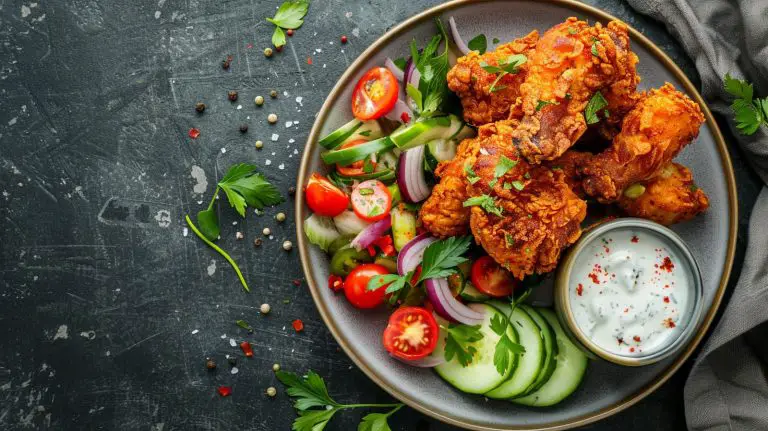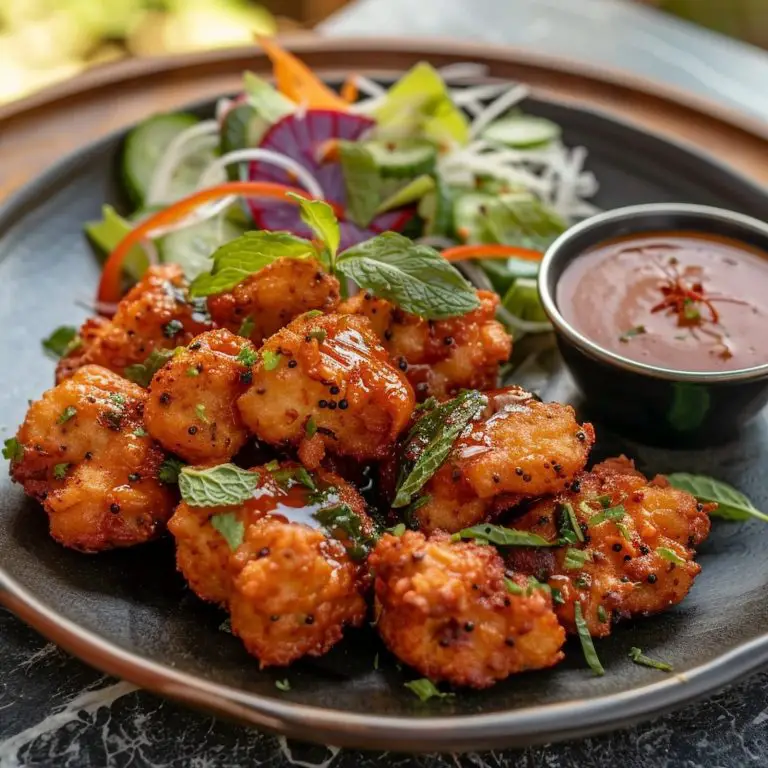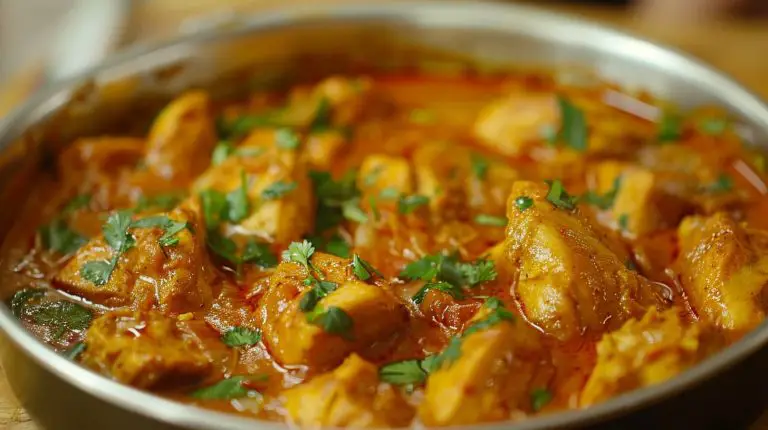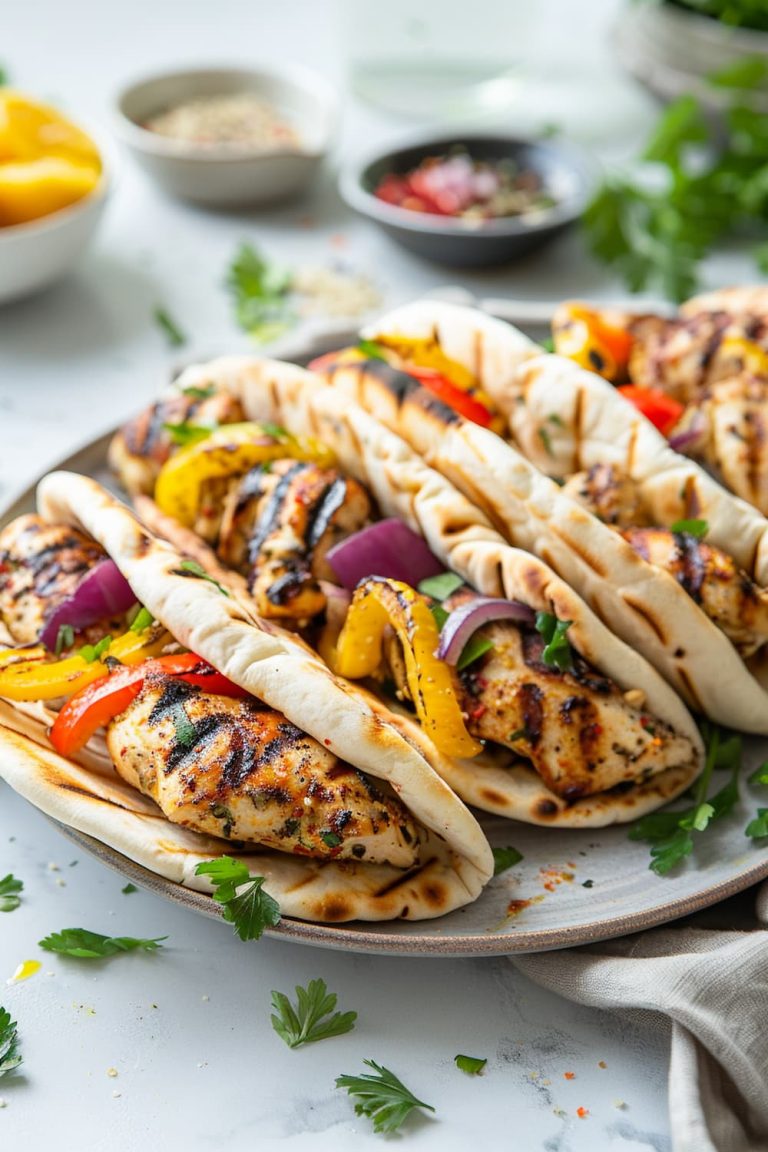Indian Chili Chicken Recipe
![glossy saucy consistency curry, [chili soy chicken]](https://tastycookingaroma.com/wp-content/uploads/2024/04/almostawake21_glossy_saucy_consistency_curry_chili_soy_chicke_f005f0d9-98f1-4956-8251-e7b98f5e61fc_2.jpg)
Indian Chili Chicken is a celebrated Indo-Chinese cuisine recipe cherished across the globe for its fiery spice and tantalizing flavors.
In just about 30 minutes, and with vibrant, punchy ingredients, you can create an authentic Indo-Chinese masterpiece right in your kitchen.
Why You’ll Love This Recipe:
- Explosive Flavors: The perfect harmony of spicy, tangy, and sweet notes ensures every bite is a taste adventure.
- Quick and Satisfying: Ready in about 30 minutes, it’s an ideal choice for a flavorful, stress-free meal.
- Adaptable: Easily adjust the spice level or swap ingredients to make it completely your own.
In this guide, you’ll learn
- Some Interesting Facts and Origin Story of Chili Chicken
- How to make Indian Chili Chicken in your kitchen
- Healthy Vegan Alternatives For The Items Used In the Recipe
- Common Mistakes To Avoid, Pro Tips To Enhance The Taste Of the Dish
- FAQs (Reader Questions Answered) and much more stuff!
So, grab your apron, and let’s dive in!
Some Interesting Facts About Indian Chili Chicken
Origins:
- Indian Chili Chicken is a hallmark of Indo-Chinese cuisine, which originated from the Chinese community that settled in Kolkata, India, in the late 19th and early 20th centuries.
- Indian Chili Chicken, specifically, is believed to have been developed in Kolkata as a way to cater to the tastes of both the local Indian population and the Chinese community, creating a fusion dish that combines the best of both worlds.
Regional Variations:
- Kolkata: The birthplace of Indo-Chinese cuisine often serves Indian Chili Chicken with a focus on tangier flavors and less heat, catering to local tastes.
- Mumbai: Here, the dish might be spicier and incorporate more garlic, reflecting the city’s love for bold flavors.
- Southern India: Variants in this region might include curry leaves or mustard seeds, adding a distinct South Indian twist to the traditional recipe.
How to make Restuarant Style Indian Chili Chicken At Home
Total Time: 45 minutes
- Preparation Time: 15 minutes
- Cooking Time: 30 minutes
- Serves: 4
Ingredients and Their Importance:
- Chicken Breast (500 grams, cut into bite-sized pieces): The lean protein source makes this dish filling, without being heavy on the stomach.
- Greek Yogurt (2 tablespoons, or coconut yogurt for dairy-free): Acts as a tenderizer for the chicken, ensuring it’s moist and flavorful.
- Ginger Paste (1 teaspoon): Adds a zesty, warm flavor and aids in digestion.
- Garlic Paste (1 teaspoon): Brings aromatic depth and has health-promoting properties.
- Turmeric Powder (½ teaspoon): Offers a beautiful color and anti-inflammatory benefits.
- Paprika or Kashmiri Chili Powder (1 teaspoon): Provides a vibrant hue and mild heat, enriching the dish’s flavor without overpowering it.
- Ground Cumin (½ teaspoon): Introduces a slightly earthy, warm essence to the marinade.
- Lemon Juice (1 tablespoon): Brightens the dish with a tangy note and helps in breaking down the proteins in chicken for better texture.
- Salt: To taste, it enhances all the other flavors in the dish.
- Olive Oil (2 tablespoons): Used for sautéing, it’s a healthier fat option that adds richness.
- Onions, Bell Peppers (2 medium onions, 1 each of red and green bell peppers, diced): These vegetables add sweetness, crunch, and nutritional value, making the dish more balanced.
- Green Chilies (2, slit): Adjustable to your heat preference, they introduce a spicy kick.
- Tomato Puree (½ cup): Forms the base of the sauce, lending a tangy sweetness and smooth texture.
- Soy Sauce (2 tablespoons, or tamari for gluten-free): Adds umami, depth, and a slight saltiness to the dish.
- Vinegar (1 tablespoon): Cuts through the richness and balances the dish.
- Honey (1 tablespoon, or maple syrup for vegan): Offers a subtle sweetness that complements the spice.
- Cornstarch (1 tablespoon, dissolved in 3 tablespoons of water): Thickens the sauce, giving it a glossy, appealing look.
- Spring Onions (for garnish): Adds a fresh, crisp finish and visual appeal.
Instructions:
Marinate the Chicken:
- Combine the Greek or coconut yogurt, ginger paste, garlic paste, turmeric, paprika/Kashmiri chili, cumin, lemon juice, and salt in a bowl.
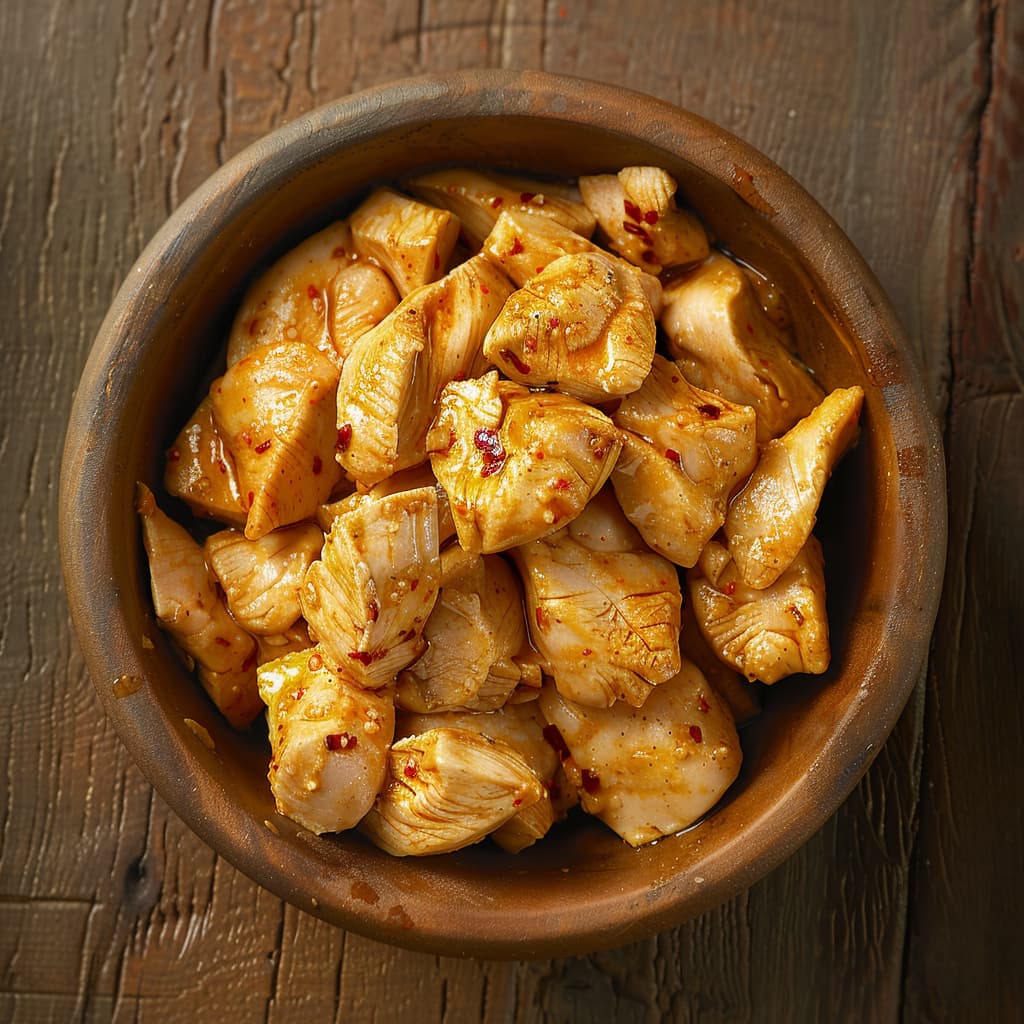
- Coat the chicken pieces well and let them marinate for at least 30 minutes. This step is crucial for infusing the chicken with flavors and ensuring tenderness.
- While a minimum of 30 minutes is recommended for marinating the chicken, letting it marinate overnight in the refrigerator can significantly deepen the flavors. But if you are leaving it overnight avoid using lemon juice or anything acidic in the marination as it may spoil the prep.
Cook the Chicken:
- Heat a tablespoon of olive oil in a large pan over medium heat. Add the marinated chicken pieces, spreading them out evenly.
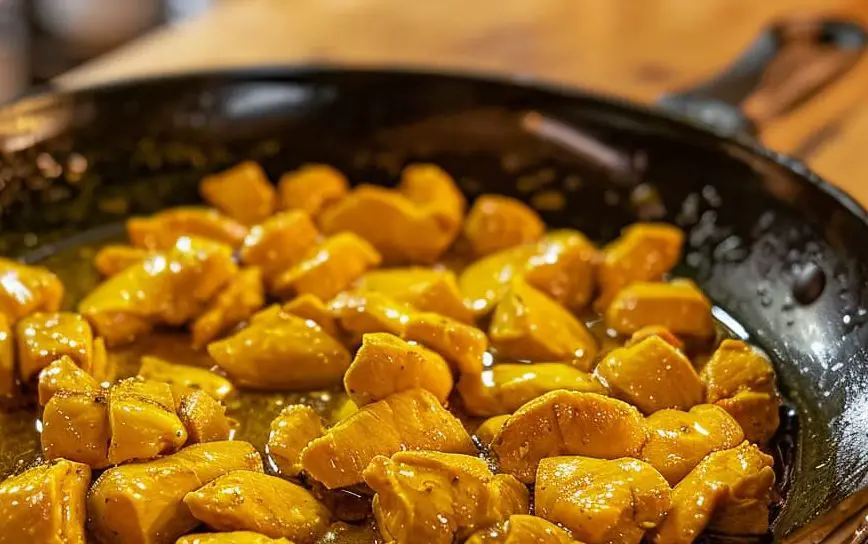
- Sauté until they are golden on all sides and cooked through about 8-10 minutes. Remove the chicken and set it aside. This process not only cooks the chicken but also builds a flavor foundation for the sauce.
- Ensure the chicken pieces are not overcrowded in the pan during the initial sautéing. Overcrowding can lead to steaming rather than browning, which might affect the texture and flavor development. Cook in batches if necessary.
Prepare the Sauce:
- In the same pan, add the remaining olive oil, followed by onions, bell peppers, and green chilies.
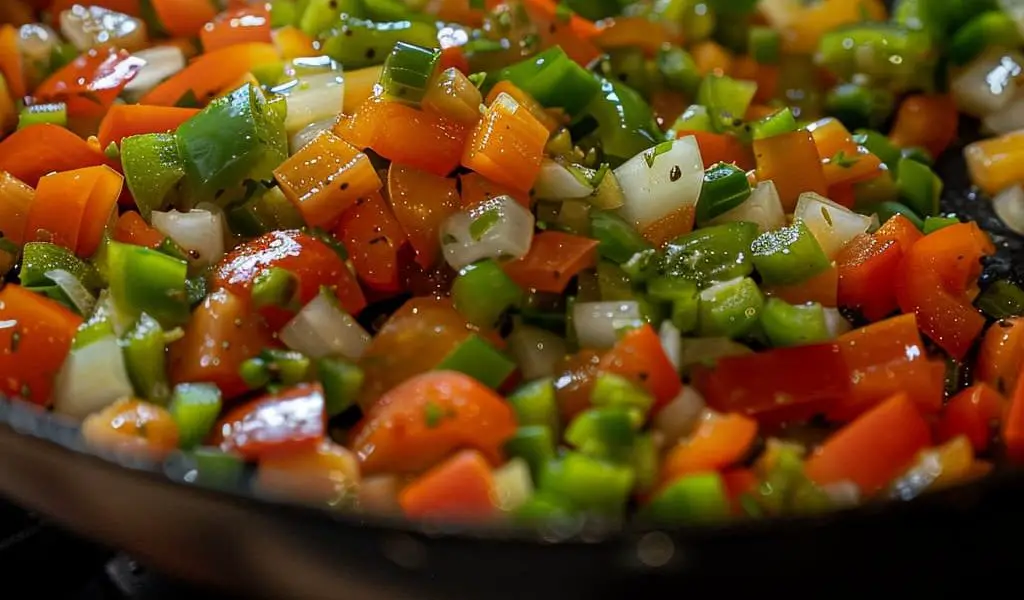
The recipe’s spice level can be tailored to individual preferences. If you’re sensitive to heat, start with less green chili and chili powder, then adjust upwards if needed. Remember, it’s easier to add more spice than to take it away.
- Sauté until they start to soften but retain some crunch, about 3-4 minutes, to add texture contrast to the dish.
- Stir in the tomato puree, soy sauce, vinegar, and honey, cooking for another 2 minutes to blend the flavors.
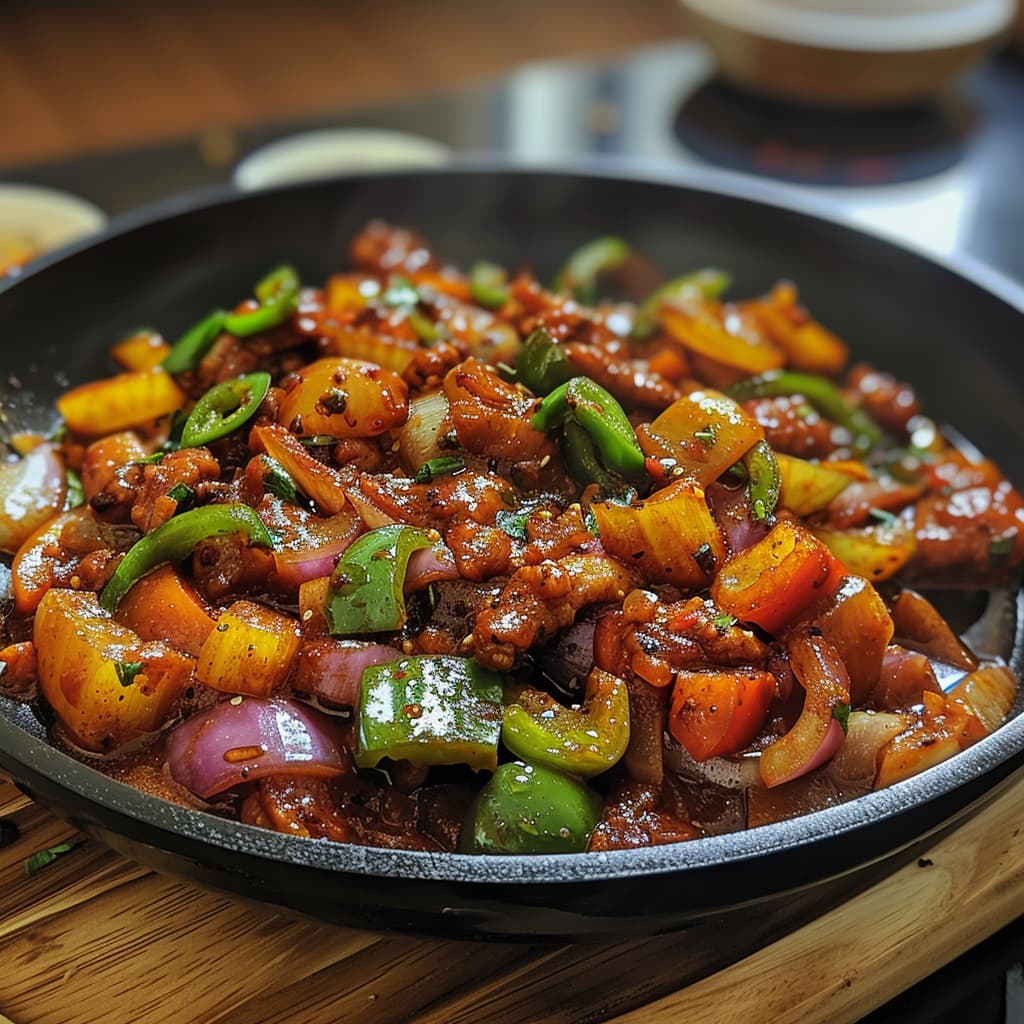
Thicken the Sauce:
Whisk in the cornstarch slurry, allowing the sauce to thicken slightly and become glossy. This step elevates the dish, giving it a restaurant-quality finish.
- After adding the cornstarch slurry, let the sauce simmer for a couple of minutes to thicken properly.
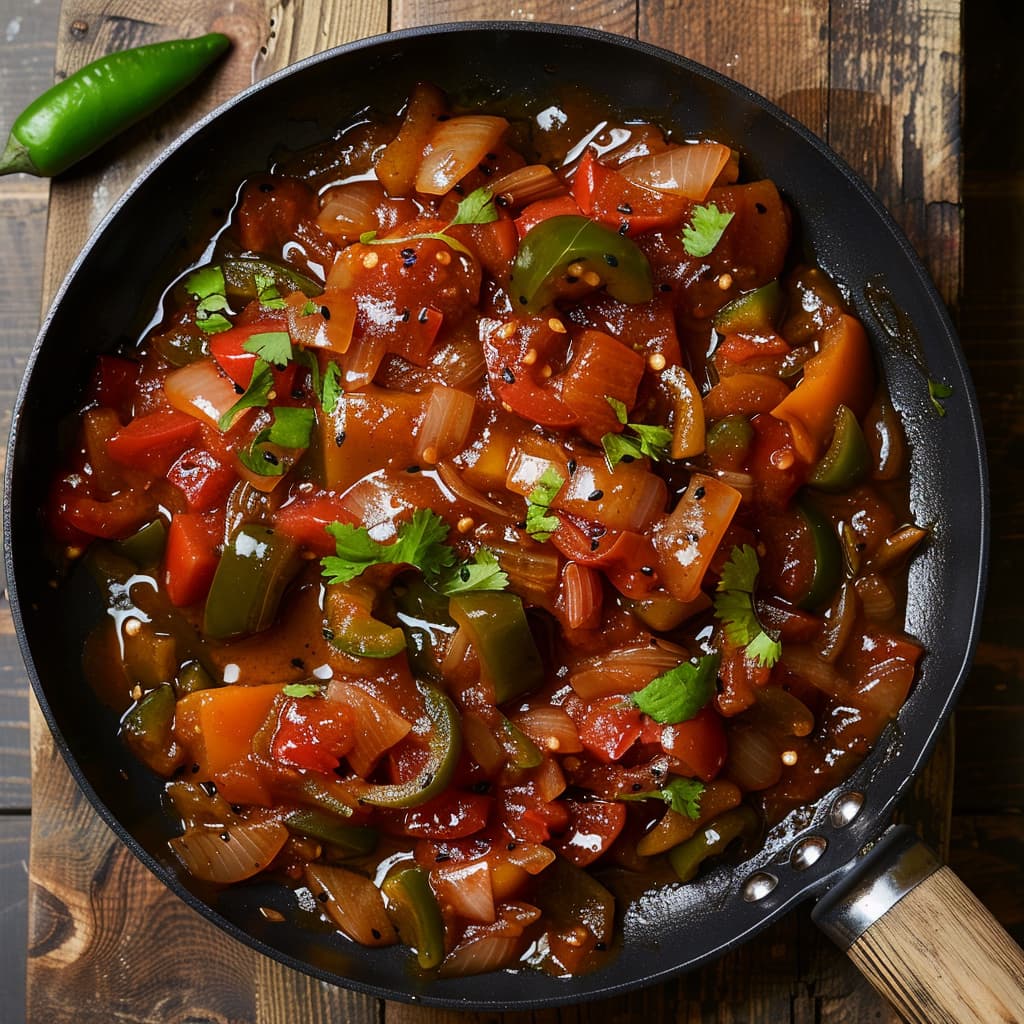
- If the sauce becomes too thick, you can thin it with a little water or chicken broth to reach your desired consistency. Conversely, if the sauce is too thin, a little more cornstarch slurry can be added to achieve the right thickness. Always add slurry gradually while stirring to avoid lumps.
Combine Chicken and Sauce:
Return the cooked chicken to the pan, tossing well to coat with the sauce. Cook together for 2-3 minutes, ensuring the chicken is heated through and enveloped in the flavorful sauce.
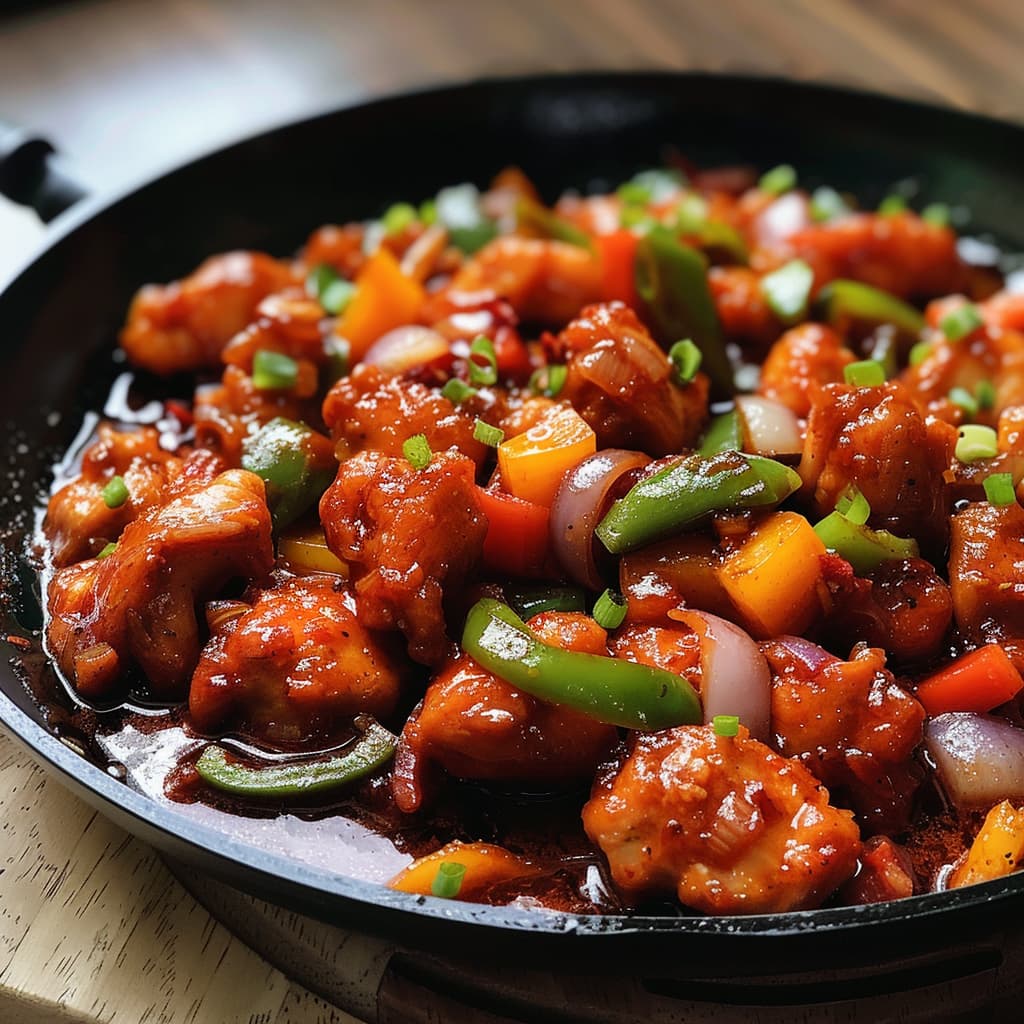
Before adding the chicken back into the sauce, taste the sauce and adjust the seasoning if needed. Balancing the flavors of soy sauce, vinegar, and honey is key to a harmonious dish.
Garnish and Serve:
Sprinkle chopped spring onions and cilantro leaves over the top for a burst of freshness and color. Serve this delightful Indian Chili Chicken hot, accompanied by steamed rice or noodles, for a complete meal.

Healthy Vegan Alternatives For The Ingredients Used In the Chili Chicken Recipe
- Chicken Breast (500 grams, cut into bite-sized pieces):
- Alternative: Use firm tofu, tempeh, or a plant-based chicken substitute. If using tofu, press it to remove excess water before cutting it into bite-sized pieces. This will be your lean protein source.
- Greek Yogurt (2 tablespoons, of coconut yogurt for dairy-free):
- Alternative: Use coconut yogurt or another plant-based yogurt. This acts as a tenderizer for the vegan “chicken” and ensures it’s moist and flavorful.
- Honey (1 tablespoon, or maple syrup for vegan):
- Alternative: Maple syrup or agave nectar. These are great vegan alternatives to honey, offering a similar sweetness that complements the spice.
Mistakes To Avoid While Making Chili Chicken
Ingredient Selection:
- Common Error: Using the wrong cut of chicken. Breast pieces can become dry if overcooked.
- Avoidance: Opt for thigh pieces for more flavor and juiciness. If using breast pieces, be careful not to overcook them.
- Ingredient Substitutions: Substituting fresh ingredients like ginger and garlic with powdered versions can significantly alter the taste.
- Avoidance: Always use fresh ginger and garlic to maintain the authenticity and vibrancy of flavors.
Preparation Pitfalls:
- Marinating Time: Skimping on marinating time can result in less flavorful chicken.
- Avoidance: Marinate the chicken for at least 1-2 hours, or overnight if possible, to deepen the flavors.
- Cutting Techniques: Inconsistent sizes of chicken pieces can lead to uneven cooking.
- Avoidance: Cut chicken into uniform pieces to ensure they cook evenly.
Cooking Techniques:
- Incorrect Temperatures: Cooking at too high a temperature can burn the spices, while too low can make the chicken soggy.
- Avoidance: Maintain a medium-high heat for frying the chicken and a medium heat for simmering the sauce to integrate flavors without burning.
- Overcrowding the Pan: Adding too much chicken at once can lower the temperature, leading to steaming rather than frying.
- Avoidance: Fry the chicken in batches to ensure it gets a nice sear and remains juicy.
Seasoning and Flavoring:
- Over or Under-Seasoning: Finding the right balance of flavors is crucial in Indian Chili Chicken.
- Avoidance: Start with less salt and spices, tasting and adjusting as you go. Remember, you can always add more, but you can’t take it away.
- Balancing Flavors: The harmony between spicy, tangy, and sweet is what makes Indian Chili Chicken distinctive.
- Avoidance: Balance the heat from the chilies with the acidity from vinegar and the sweetness from tomato sauce or a hint of sugar to achieve the perfect flavor profile.
Presentation Tips:
- Clumpy Sauce: A sauce that’s too thick or unevenly coated can affect the dish’s appeal.
- Avoidance: If the sauce thickens too much, thin it out with a little water or chicken broth for a silky consistency that beautifully coats the chicken.
- Garnishing: An unappealing presentation can diminish the dish’s visual appeal.
- Avoidance: Garnish with spring onions, sesame seeds, or fresh cilantro leaves to add color and enhance the dish visually.
Pairing Suggestions for Chili Chicken
- Beverages: Complement the spicy kick of Indian Chili Chicken with a cooling drink, such as a cucumber mint cooler or a sweet mango lassi. For those who enjoy a bit of alcohol, a crisp, cold beer or a Riesling wine, known for its sweet and acidic balance, can also pair wonderfully.
- Side Dishes: A side of fluffy jasmine or basmati rice works well to absorb the rich flavors of the sauce. For a low-carb option, cauliflower rice can be a great substitute. Stir-fried vegetables, such as broccoli, bell peppers, or bok choy, add a nutritious and colorful side that balances the dish’s heat.
- Main Courses: If Indian Chili Chicken is part of a larger meal, consider complementing it with milder dishes to offer a variety of flavors. A creamy dal makhani or palak paneer can provide a soothing contrast to the chili chicken’s spice.
Seasonal Variation for Indian Chili Chicken
- Spring: Lighten up the dish by adding spring vegetables like snap peas or asparagus into the mix. These can be quickly stir-fried and added towards the end of cooking to retain their crispness and bright, fresh flavors.
- Summer: Incorporate summer fruits like pineapple or mango into the dish for a sweet contrast to the heat. These can be added in the last few minutes of cooking to warm through without becoming mushy.
- Fall: Embrace the heartier vegetables of fall, such as pumpkin or sweet potatoes, cubed and roasted before being added to the chili chicken. Their sweetness complements the spicy and tangy flavors beautifully.
- Winter: In colder months, adding a bit more heat through additional chilies or even a touch of warming spices like cinnamon can be comforting. Winter greens like kale or Swiss chard, sautéed and mixed in, can also add a nutritious boost.
Always Keep In Mind, that the inclusion of newer veggies or spices can end up impacting the overall taste of the dish, so you may need to adjust your other spices or salt portions to counter that.
Common Problems You May Face While Cooking Chili Chicken
- Overcooking the Chicken:
- Solution: Keep a close eye on the cooking time, especially when frying or sautéing the chicken. Chicken pieces should be turned frequently and checked for doneness by cutting a larger piece to see if the inside is no longer pink.
- Spices Burning in the Pan:
- Solution: Spices can burn quickly, especially on high heat, imparting a bitter taste. To avoid this, add spices to the oil at a medium heat and stir continuously. If you’re worried about burning, you can also mix the spices with a little water to make a paste before adding them to the pan, which helps prevent burning.
- Sauce Too Thick or Too Thin:
- Solution: Finding the right sauce consistency can be tricky. If your sauce is too thick, gradually add water or chicken broth, stirring constantly until you reach the desired consistency. If it’s too thin, mix a small amount of cornstarch with water and stir it into the sauce, allowing it to simmer and thicken.
- Balancing Flavors:
- Solution: Achieving the perfect balance of spicy, tangy, and sweet can be challenging. Start with conservative amounts of soy sauce, vinegar, and sugar, then taste and adjust accordingly. Remember, it’s easier to add more than to correct an overly seasoned dish.
- Chicken Not Absorbing Flavors:
- Solution: Marinate the chicken for at least 1-2 hours, or overnight if possible, to ensure it absorbs the flavors. Make sure to cut the chicken into smaller pieces to increase the surface area for the marinade to work its magic.
- Vegetables Overcooked or Undercooked:
- Solution: Add vegetables according to their cooking times; start with the ones that take longer to cook, like onions and bell peppers, and add quicker-cooking vegetables, like scallions, towards the end. This method ensures all vegetables are perfectly cooked.
- Handling Chili Heat:
- Solution: If you’re sensitive to spice, start with a smaller amount of chili and adjust as you taste. You can always add more spice, but it’s difficult to tone it down once it’s in the dish. Serving the dish with a side of yogurt or raita can also help mellow the heat.
Pro Tips for Perfecting Chili Chicken
- Marinating is Key: For deeper flavor infusion, let the chicken marinate for at least 2 hours or, ideally, overnight. The acids in the marinade (like vinegar or lemon juice) help tenderize the chicken, allowing spices to penetrate more deeply.
- Velveting Technique: Borrowing from Chinese cooking, the velveting technique involves coating the chicken in a mixture of cornstarch and egg white before frying. This creates a silky texture on the chicken, locking in juices and enhancing the dish’s overall mouthfeel.
- Layering Flavors: Build layers of flavor by sautéing aromatics (onion, garlic, ginger) until golden before adding any liquids. This caramelization process adds depth and richness to the dish.
- Control the Heat: Adjust the spiciness to your preference by modifying the amount of green chilies and chili sauce. Always taste your sauce as you cook, balancing the heat with acidity (vinegar) and sweetness (sugar or honey) to achieve a harmonious flavor profile.
FAQs about Chili Chicken (Reader Questions Answered)
Q: Can I use bone-in chicken instead of boneless?
A: Yes, bone-in chicken can be used for a richer flavor, but it will increase the cooking time. Cut the chicken into smaller pieces to ensure it cooks evenly.
Q: How can I make Indian Chili Chicken without frying?
A: For a healthier version, you can bake the marinated chicken at 375°F (190°C) for 20-25 minutes until cooked through, then toss it in the sauce prepared on the stove.
Q: Can I make this dish vegetarian?
A: Absolutely! Substitute chicken with paneer, tofu, or mixed vegetables like bell peppers, broccoli, and mushrooms for a vegetarian version. Adjust cooking times accordingly.
Q: What if I don’t have cornstarch for the sauce?
A: You can use all-purpose flour as a thickener, though it might not be as clear and glossy. Start with half the amount and adjust as needed.
Q: How can I prevent the chicken from drying out?
A: Avoid overcooking by using medium-high heat for a quick sear and then simmering the chicken in the sauce just until it’s cooked through.
Q: Can I prepare any part of this dish ahead of time?
A: Yes, you can marinate the chicken overnight and prepare the sauce in advance. Simply combine and heat through when ready to serve.
Closing Thoughts
To create a full meal that complements Indian Chili Chicken, consider exploring recipes like vegetable fried rice or hakka noodles for a delightful Indo-Chinese feast. A side of cucumber salad can offer a refreshing contrast to the spicy chicken. For dessert, a light mango pudding would perfectly round off the meal, offering a sweet end to the spicy journey.
I’m excited for you to try making Indian Chili Chicken and to hear about your culinary adventures. Whether you stick to the classic recipe or infuse it with your personal touch, Don’t hesitate to share your variations, tips, or questions in the comments below. Happy cooking
![glossy saucy consistency curry, [chili soy chicken]](https://tastycookingaroma.com/wp-content/uploads/2024/04/almostawake21_glossy_saucy_consistency_curry_chili_soy_chicke_f005f0d9-98f1-4956-8251-e7b98f5e61fc_2-500x500.jpg)
Indian Chili Chicken Recipe
Ingredients
- Chicken Breast 500 grams, cut into bite-sized pieces: The lean protein source makes this dish filling, without being heavy on the stomach.
- Greek Yogurt 2 tablespoons, or coconut yogurt for dairy-free: Acts as a tenderizer for the chicken, ensuring it's moist and flavorful.
- Ginger Paste 1 teaspoon: Adds a zesty, warm flavor and aids in digestion.
- Garlic Paste 1 teaspoon: Brings aromatic depth and has health-promoting properties.
- Turmeric Powder ½ teaspoon: Offers a beautiful color and anti-inflammatory benefits.
- Paprika or Kashmiri Chili Powder 1 teaspoon: Provides a vibrant hue and mild heat, enriching the dish's flavor without overpowering it.
- Ground Cumin ½ teaspoon: Introduces a slightly earthy, warm essence to the marinade.
- Lemon Juice 1 tablespoon: Brightens the dish with a tangy note and helps in breaking down the proteins in chicken for better texture.
- Salt: To taste it enhances all the other flavors in the dish.
- Olive Oil 2 tablespoons: Used for sautéing, it's a healthier fat option that adds richness.
- Onions Bell Peppers (2 medium onions, 1 each of red and green bell peppers, diced): These vegetables add sweetness, crunch, and nutritional value, making the dish more balanced.
- Green Chilies 2, slit: Adjustable to your heat preference, they introduce a spicy kick.
- Tomato Puree ½ cup: Forms the base of the sauce, lending a tangy sweetness and smooth texture.
- Soy Sauce 2 tablespoons, or tamari for gluten-free: Adds umami, depth, and a slight saltiness to the dish.
- Vinegar 1 tablespoon: Cuts through the richness and balances the dish.
- Honey 1 tablespoon, or maple syrup for vegan: Offers a subtle sweetness that complements the spice.
- Cornstarch 1 tablespoon, dissolved in 3 tablespoons of water: Thickens the sauce, giving it a glossy, appealing look.
- Spring Onions for garnish: Adds a fresh, crisp finish and visual appeal.
Instructions
Marinate the Chicken:
- Combine the Greek or coconut yogurt, ginger paste, garlic paste, turmeric, paprika/Kashmiri chili, cumin, lemon juice, and salt in a bowl.
- Coat the chicken pieces well and let them marinate for at least 30 minutes. This step is crucial for infusing the chicken with flavors and ensuring tenderness.
- While a minimum of 30 minutes is recommended for marinating the chicken, letting it marinate overnight in the refrigerator can significantly deepen the flavors. But if you are leaving it overnight avoid using lemon juice or anything acidic in the marination as it may spoil the prep.
Cook the Chicken:
- Heat a tablespoon of olive oil in a large pan over medium heat. Add the marinated chicken pieces, spreading them out evenly.
- Sauté until they are golden on all sides and cooked through about 8-10 minutes. Remove the chicken and set it aside. This process not only cooks the chicken but also builds a flavor foundation for the sauce.
- Ensure the chicken pieces are not overcrowded in the pan during the initial sautéing. Overcrowding can lead to steaming rather than browning, which might affect the texture and flavor development. Cook in batches if necessary.
Prepare the Sauce:
- In the same pan, add the remaining olive oil, followed by onions, bell peppers, and green chilies.
- The recipe's spice level can be tailored to individual preferences. If you're sensitive to heat, start with less green chili and chili powder, then adjust upwards if needed. Remember, it's easier to add more spice than to take it away.
- Sauté until they start to soften but retain some crunch, about 3-4 minutes, to add texture contrast to the dish.
- Stir in the tomato puree, soy sauce, vinegar, and honey, cooking for another 2 minutes to blend the flavors.
Thicken the Sauce:
- Whisk in the cornstarch slurry, allowing the sauce to thicken slightly and become glossy. This step elevates the dish, giving it a restaurant-quality finish.
- After adding the cornstarch slurry, let the sauce simmer for a couple of minutes to thicken properly.
- If the sauce becomes too thick, you can thin it with a little water or chicken broth to reach your desired consistency. Conversely, if the sauce is too thin, a little more cornstarch slurry can be added to achieve the right thickness. Always add slurry gradually while stirring to avoid lumps.
Combine Chicken and Sauce:
- Return the cooked chicken to the pan, tossing well to coat with the sauce. Cook together for 2-3 minutes, ensuring the chicken is heated through and enveloped in the flavorful sauce.
- Before adding the chicken back into the sauce, taste the sauce and adjust the seasoning if needed. Balancing the flavors of soy sauce, vinegar, and honey is key to a harmonious dish.
Garnish and Serve:
- Sprinkle chopped spring onions and cilantro leaves over the top for a burst of freshness and color. Serve this delightful Indian Chili Chicken hot, accompanied by steamed rice or noodles, for a complete meal.

